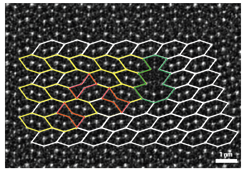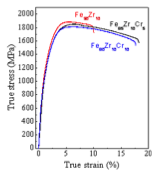Materials for structural applications
mechanical properties of CMA and related composites
Mechanical properties of CMA remain an open subject. Because of the complex atomic structure and large unit cell of CMA, the usual plastic deformation mechanisms observed in simple metals, with dislocations, are no longer valid. For instance, new deformation mechanisms such as meta-dislocation have been evidenced using HREM TEM (figure below, left panel) for some Al-based CMA (1). This opens a new field of research, where much remains to be done.
CMAs are by themselves brittle and cannot be used as structural materials. However they can be used as re-enforcement particles in composites structure. Promising results have been obtained in Fe based alloys (see Figure below, right panel). A main objective is to understand the strengthening mechanisms and find proper heat treatment or alloying to obtain desired composites (2).
Composites containing CMA phases can be elaborated either artificially by for instance powder metallurgy or by in situ method like eutectic solidification or solid state transformation. Both routes are interesting since they have their own drawbacks and advantages. While the in situ process allows for the elaboration of thermodynamically stable systems the artificial methods allows for systems out of reach for equilibrium process. Hence the elaboration process provides another way to design new composites. Having several possibilities for tuning the system and consequently the properties will be especially important to develop multifunctional composites. In the next years, it is planned to develop Mg based composites, since Mg systems are favoured because of their potential interest for several types of applications and in particular for weight saving. Preliminary results already show that composites displays at high temperature a deformation ability close to the one exhibited by related CMA phases (3). The proposed approach will combine an experimental approach together with a multi-scale simulation.
Similarly, studies on light Al-Li alloys for aeronautics, where the microstructure involves complex phases, will be investigated using ab-initio and/or adapted Hamiltonian techniques.


Figure : Left panel: example of a metadislocation imaged by HREM TEM in the Al-Pd-Mn phase (1). Right panel: Stress-strain curve for different Fe based composites. The plastic behavior is much improved.
1. M. Heggen, L. Houben, M. Feuerbacher, Plastic deformation mechanism in complex solids. Nature Materials 9, 2010, 332 – 336.
2. S. Scudino, P. Donnadieu, K.B. Surreddi, K. Nikolowski, M. Stoica, J. Eckert. Microstructure and mechanical properties of Laves phase-reinforced Fe-Zr-Cr alloys, Intermetallics 17, 2009, 532-539.
3. J. Ragani, P. Donnadieu, C. Tassin, J.J. Blandin High temperature deformation of the gamma-Mg17Al12 complex metallic alloy, Scripta Materialia, 65, 3, 2011, 253-256
RAD leader: P. Donnadieu
